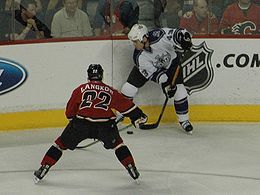Game
Each National Hockey League regulation game is played between two teams and is 60 minutes long. The game is composed of three 20-minute periods with an intermission of either 15? or 17 minutes (if nationally televised) between periods.[61] Television timeouts are taken at the first stoppage of play after 6, 10, and 14 minutes of elapsed time unless there is a power play or the first stoppage is the result of a goal scored. In these cases, the timeout will occur at the first stoppage after the penalty expires or the next stoppage after the goal, respectively. A new rule was introduced for the 2007–08 season that if the first stoppage of play is an icing, the TV timeout does not occur. This is to prevent players from getting a break despite not being allowed to change. At the end of the 60-minute regulation time, the team with the most goals wins the game. If a game is tied after regulation time, overtime ensues. During the regular season, overtime is a five-minute, four-player on four-player sudden-death period, in which the first team to score a goal wins the game. Until the 2005–06 season, if no team was able to score in the five-minute overtime, the game ended in a tie. Beginning in the 2005–06 season, if the game is still tied at the end of overtime, the game enters a shootout. Three players for each team in turn take a penalty shot. The team with the most goals during the three-round shootout wins the game. If the game is still tied after the three shootout rounds, the shootout continues but becomes sudden death. Whichever team ultimately wins the shootout is awarded a goal in the game score and thus awarded two points in the standings. The losing team in overtime or shootout is

awarded only one.[62] Shootout goals and saves are not tracked in hockey statistics; shootout statistics are tracked separately. Shootouts do not occur during the playoffs. In the playoffs, sudden-death 20-minute five-on-five periods are played until one team scores. While in theory a game could continue indefinitely, only four games have reached five overtime periods, two have reached six, and none have gone beyond six.[63] There are no television timeouts during playoff overtime periods; the only break is to clean the loose ice at the first stoppage after the period is halfway finished. National Hockey League games are played on a rectangular hockey rink with rounded corners surrounded by walls and plexiglass. It measures 25.91 by 60.92 metres (85 by 200 ft) in the NHL,[65] approximately the same length but much narrower than International Ice Hockey Federation standards. The center line divides the ice in half,[66] and is used to judge icing violations. There are two blue lines that divide the rink roughly into thirds, which divide the ice into two attacking and one neutral zone.[66] Near the end of both ends of the rink, there is a thin red goal line spanning the width of the ice, which is used to judge goals and icing calls. Starting in the 2005–2006 season, after testing in the American Hockey League, a trapezoidal area behind each goal net has been introduced.[67] The goaltender can play the puck only within the trapezoid or in front of the goal line; if the goaltender plays the puck behind the goal line and outside the trapezoidal area, a two minute minor penalty for delay of game is assessed by the referees.[68] The rule is unofficially nicknamed the "Martin Brodeur rule"